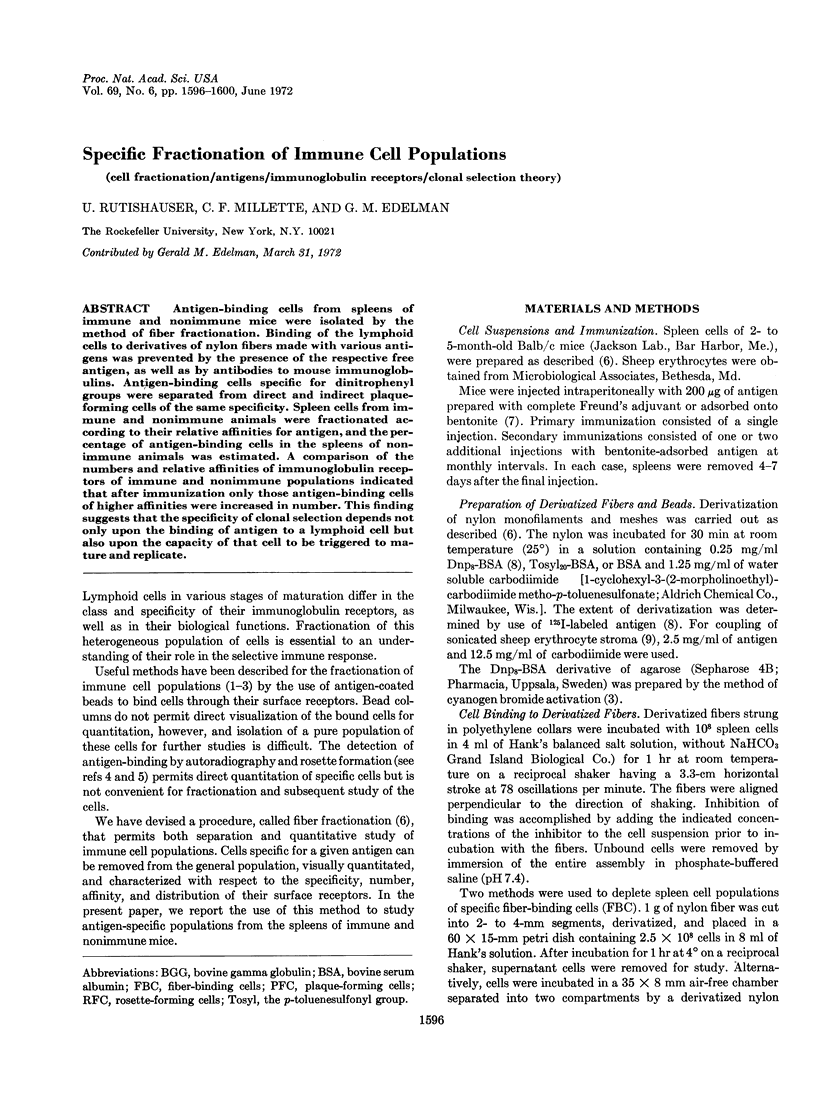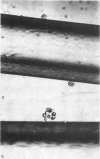Abstract
Antigen-binding cells from spleens of immune and nonimmune mice were isolated by the method of fiber fractionation. Binding of the lymphoid cells to derivatives of nylon fibers made with various antigens was prevented by the presence of the respective free antigen, as well as by antibodies to mouse immunoglobulins. Antigen-binding cells specific for dinitrophenyl groups were separated from direct and indirect plaque-forming cells of the same specificity. Spleen cells from immune and nonimmune animals were fractionated according to their relative affinities for antigen, and the percentage of antigen-binding cells in the spleens of nonimmune animals was estimated. A comparison of the numbers and relative affinities of immunoglobulin receptors of immune and nonimmune populations indicated that after immunization only those antigen-binding cells of higher affinities were increased in number. This finding suggests that the specificity of clonal selection depends not only upon the binding of antigen to a lymphoid cell but also upon the capacity of that cell to be triggered to mature and replicate.
Keywords: cell fractionation, antigens, immunoglobulin receptors, clonal selection theory
Full text
PDF




Images in this article
Selected References
These references are in PubMed. This may not be the complete list of references from this article.
- DODGE J. T., MITCHELL C., HANAHAN D. J. The preparation and chemical characteristics of hemoglobin-free ghosts of human erythrocytes. Arch Biochem Biophys. 1963 Jan;100:119–130. doi: 10.1016/0003-9861(63)90042-0. [DOI] [PubMed] [Google Scholar]
- Davie J. M., Paul W. E. Receptors on immunocompetent cells. I. Receptor specificity of cells participating in a cellular immune response. Cell Immunol. 1970 Oct;1(4):404–418. doi: 10.1016/0008-8749(70)90017-1. [DOI] [PubMed] [Google Scholar]
- Davie J. M., Paul W. E. Receptors on immunocompetent cells. V. Cellular correlates of the "maturation" of the immune response. J Exp Med. 1972 Mar 1;135(3):660–674. doi: 10.1084/jem.135.3.660. [DOI] [PMC free article] [PubMed] [Google Scholar]
- Edelman G. M., Rutishauser U., Millette C. F. Cell fractionation and arrangement on fibers, beads, and surfaces. Proc Natl Acad Sci U S A. 1971 Sep;68(9):2153–2157. doi: 10.1073/pnas.68.9.2153. [DOI] [PMC free article] [PubMed] [Google Scholar]
- McConnell I. Antigen receptors on the surface of antibody-secreting cells. Nat New Biol. 1971 Oct 6;233(40):177–179. doi: 10.1038/newbio233177a0. [DOI] [PubMed] [Google Scholar]
- Rittenberg M. B., Pratt K. L. Antitrinitrophenyl (TNP) plaque assay. Primary response of Balb/c mice to soluble and particulate immunogen. Proc Soc Exp Biol Med. 1969 Nov;132(2):575–581. doi: 10.3181/00379727-132-34264. [DOI] [PubMed] [Google Scholar]
- Siskind G. W., Benacerraf B. Cell selection by antigen in the immune response. Adv Immunol. 1969;10:1–50. doi: 10.1016/s0065-2776(08)60414-9. [DOI] [PubMed] [Google Scholar]
- Truffa-Bachi P., Wofsy L. Specific separation of cells on affinity columns. Proc Natl Acad Sci U S A. 1970 Jul;66(3):685–692. doi: 10.1073/pnas.66.3.685. [DOI] [PMC free article] [PubMed] [Google Scholar]
- Wigzell H., Andersson B. Cell separation on antigen-coated columns. Elimination of high rate antibody-forming cells and immunological memory cells. J Exp Med. 1969 Jan 1;129(1):23–36. doi: 10.1084/jem.129.1.23. [DOI] [PMC free article] [PubMed] [Google Scholar]
- Wilson J. D. The relationship of antibody-forming cells to rosette-forming cells. Immunology. 1971 Aug;21(2):233–245. [PMC free article] [PubMed] [Google Scholar]
- Yahara I., Edelman G. M. Restriction of the mobility of lymphocyte immunoglobulin receptors by concanavalin A. Proc Natl Acad Sci U S A. 1972 Mar;69(3):608–612. doi: 10.1073/pnas.69.3.608. [DOI] [PMC free article] [PubMed] [Google Scholar]




